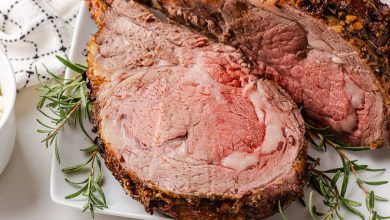Veal (Raw, Composite of Rib and Loin Cuts)
Veal, sourced from young cattle, is a lean meat that offers a mild and tender texture, making it a versatile option for a wide range of dishes. It’s commonly used in steaks, roasts, and cuts for braising or stewing. In its raw form, veal is considered a high-protein meat, providing essential nutrients like iron, zinc, and B vitamins.
Nutritional Information (Per 100g Raw Veal)
| Nutrient | Amount |
|---|---|
| Energy | 112.0 kcal |
| Protein | 20.2 g |
| Total Fat | 2.87 g |
| Saturated Fat | 0.86 g |
| Carbohydrates | 0.0 g |
| Dietary Fiber | 0.0 g |
| Sugars | 0.0 g |
| Calcium | 15.0 mg |
| Iron | 0.85 mg |
| Magnesium | 25.0 mg |
| Phosphorus | 211.0 mg |
| Potassium | 328.0 mg |
| Sodium | 86.0 mg |
| Zinc | 3.23 mg |
| Copper | 0.113 mcg |
| Manganese | 0.029 mg |
| Selenium | 8.6 mcg |
| Vitamin C | 0.0 mg |
| Thiamin (Vitamin B1) | 0.08 mg |
| Riboflavin (Vitamin B2) | 0.28 mg |
| Niacin (Vitamin B3) | 7.83 mg |
| Vitamin B6 | 0.43 mg |
| Folate | 13.0 mcg |
| Vitamin B12 | 1.4 mcg |
| Vitamin A | 0.0 mcg |
| Vitamin E | 0.26 mg |
| Vitamin D2 | 0.0 mcg |
Allergen Information:
Veal does not contain common allergens like gluten, dairy, or nuts. However, it’s important to note that individuals with specific meat sensitivities or those who follow strict dietary practices (such as vegetarians or vegans) should avoid consuming veal.
Dietary Preferences:
- High Protein: Veal is an excellent source of lean protein, making it suitable for high-protein and low-fat diets.
- Low Carb: It contains zero carbohydrates, making it ideal for those following ketogenic or low-carb eating plans.
- Iron-Rich: With a notable amount of iron, veal supports those in need of iron-rich foods, such as individuals with iron-deficiency anemia.
- Rich in B Vitamins: Particularly high in niacin (vitamin B3) and B6, veal helps support metabolic function and energy production.
Cooking Tips:
Veal’s delicate flavor and tender texture benefit from quick cooking methods, like grilling, pan-searing, or braising. To preserve its juiciness and prevent overcooking, it’s important to cook veal to the right level of doneness — typically medium-rare to medium for cuts like veal chops or steaks. If you prefer slow cooking, veal’s more connective cuts, such as shoulder or shank, become wonderfully tender when braised or stewed.
For the best results, pair veal with complementary seasonings such as fresh herbs (like thyme or rosemary), garlic, and citrus, which enhance its natural flavors.
Conclusion:
Veal offers a lean, high-protein option rich in essential vitamins and minerals. With its versatile use in a variety of dishes, from roasts to stews, veal can be an elegant and nutritious addition to any meal. Its low carbohydrate content also makes it a suitable choice for many modern dietary preferences. When handled with care and cooked to perfection, veal can elevate your culinary creations with its tender texture and mild flavor profile.










